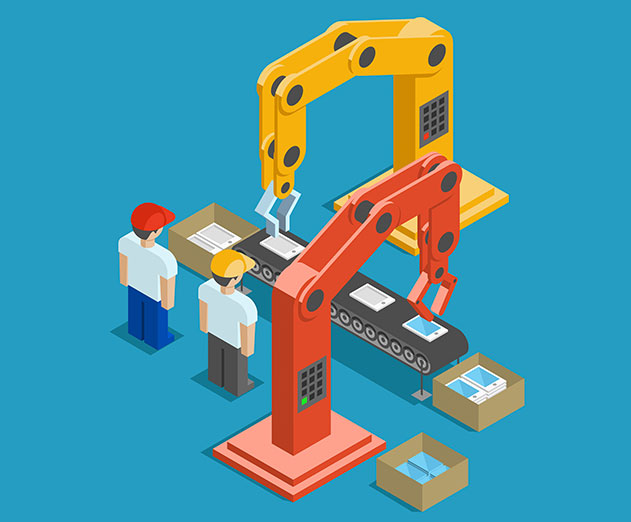Enterprise
6 ways your company could be using automation software
Friday, January 5, 2018

|
Steve Allen |

Six reasons why enterprises should adopt business process automation tools and everything you need to know about them.
When it comes to robots and our future as human beings, there are two different directions your imagination might take you. On one hand, you’ve probably watched terrifying imaginings of machines turning against mankind in films like The Matrix and The Terminator. In contrast, if you look around at the real world, you see can the reality of machines working side by side with humans every day, at work, at home, in schools - pretty much everywhere you turn.
Robotics can be found in the manufacturing sector in an obvious and physical way, with robotic arms and other machines doing manual labor. But it’s also present in a behind-the-scenes capacity within other industries and specializations, including healthcare, banking, accounting, hospitality, education, and more. In these cases, our robotic assistants are given names like “Process and Data Automation” or “Robotic Process Automation.”
When businesses find themselves looking for process improvement tools, generally they’re interested in a business process automation platform, which includes workflow automation, document management capabilities, electronic forms, and OCR (optical character recognition) software. Each of these tools plays a role in today’s process improvement methodologies. It’s not that they replace human workers. What they do is allow for human workers to do less busywork and more high-value tasks.
With all of that in mind, how can you determine if it makes sense for your business to invest in automation software? Let’s take a look at the benefits of process and data automation and how your company could be using automation software.
Take a stroll around your office. What do you see? It is overrun with filing cabinets? Are vacant offices being used to house boxes and boxes full of paper files? If so, do you think perhaps it’s time to go paperless? It might be hard to imagine how your current processes could be transformed into paperless process. That’s not an uncommon feeling. That said, once you make the transition, you might find yourself wondering how you ever did things manually on paper, and wondering why you waited so long to make your documents electronic and your processes automated.
This fear of change is real, but so are the benefits of going paperless. Plus, a good document management system is going to pave the way toward process automation. It might look like this: when documents are submitted to your document management system, OCR software reads the data on the documents and files them automatically for you. Additionally, electronic forms can be created and hosted within your document management system (for internal use by your team) or on an external website (for submissions by people outside of your company). These paperless forms can be used to kick off processes within your organization.
How does your company keep track of things like a document’s history and revisions, the current location of a file, or which step a process is on? You probably have a system for tracking these items, but it may not be the most efficient process. A lot of time, paper-based companies will put a place-holder within a physical folder when the file is borrowed, letting anyone looking for the file know exactly who has it. But how often are those files misplaced or never returned? And isn’t it a waste of time for employees to have to wait around for another person to finish with the file?
This is a problem that exists all over the business world, but it doesn’t have to. Bots make this kind of thing easy. With business process automation tools, it’s simple to find a document and view its previous versions. Digital signatures mean that documents never need to be printed and re-scanned. All of your workflows can be tracked and reported on, using analytics.
Further, your document management system can make audits and compliance look easy. Certain documents (like I-9s for new hires) can be designated as required, and the system can be set up to notify you if they aren’t submitted. If your company is audited, a simple search can pull up all of the stored documents that the auditors will need, freeing your team to continue doing their work, rather than occupying their time searching through paper files. If audits are a threat in your line of business, a document management platform may be able to set your mind at ease.
As more and more Millennials enter the workforce, training methods are shifting. New workers are quick to learn new technology, and they also carry the expectation that their work will be rewarding and that they will get to use their skillsets. If something can be automated, they will expect it to be. As more and more businesses invest in process improvement tools, one of the benefits they’ll see is easier, more consistent training for new hires. These automation tools can help managers train the next generation.
If your accounting department isn’t using the cloud yet, you’re in the minority. In fact, an article on accountingtoday.com predicted that nearly 90% of large accounting firms would be using cloud-based accounting practices by the end of 2017. Document management software, OCR software, electronic forms, and robotic process automation all go hand-in-hand with cloud-based work.
Among the many benefits is the security of a cloud-based document management system. When your data and documents are all stored in the cloud (meaning that they’re stored on a server at a secure, remote location), your business is more protected from natural disasters as well as data breaches. When you let the experts take care of your data for you, you can be more confident that it is safe from a wide range of threats.
Another benefit of having cloud-based processes is that the documents your team needs are available from any location. All they need is an internet connection. Today’s employees are looking for flexible schedules and the option of working from home as needed. When your processes are automated and cloud-based, your team can work from anywhere.
What is robotic process automation exactly? For starters, it allows you to automate specific tasks within a process. Simple, threshold-based decisions can be made by Bots (task automation robots within the software). Documents can be routed automatically to whomever needs them. Data entry can be completed using OCR, without anyone on your team having to spend hours of his or her day glued to the 10-key. Tasks that were once tedious, like data entry and 3-way matching, become automated to the point where a user only has to examine the documents if there is an error or exception.
When applied at the right company, these automation tools can save a significant amount of time and money. For example, after implementing process automation within their accounting department, Alimera Sciences saw a 93% reduction in overall invoice processing time. This goes beyond simply making a person’s job easier. It saves time, money, and effort, all while making room for future growth.
When your processes are paperless, they’re much easier to oversee. Reports and analytics can allow you, as a manager, to view the processes that are pending, in process, and completed. You can see who is doing what, and you can see how long each step of the process is taking. If work is getting backed up, you’ll be able to find out which step is clogging up the works. This can also help you when it comes time to do annual reviews.
Interested in investing in automation software and joining the ranks of organizations like Goodwill Industries of Middle Tennessee, who saw an annual saving of $100,000 through business process automation? Dig a little deeper, and see what automation can do for you!
This content is made possible by a guest author, or sponsor; it is not written by and does not necessarily reflect the views of App Developer Magazine's editorial staff.
Robotics can be found in the manufacturing sector in an obvious and physical way, with robotic arms and other machines doing manual labor. But it’s also present in a behind-the-scenes capacity within other industries and specializations, including healthcare, banking, accounting, hospitality, education, and more. In these cases, our robotic assistants are given names like “Process and Data Automation” or “Robotic Process Automation.”
When businesses find themselves looking for process improvement tools, generally they’re interested in a business process automation platform, which includes workflow automation, document management capabilities, electronic forms, and OCR (optical character recognition) software. Each of these tools plays a role in today’s process improvement methodologies. It’s not that they replace human workers. What they do is allow for human workers to do less busywork and more high-value tasks.
With all of that in mind, how can you determine if it makes sense for your business to invest in automation software? Let’s take a look at the benefits of process and data automation and how your company could be using automation software.
Eliminating Paper Waste
Take a stroll around your office. What do you see? It is overrun with filing cabinets? Are vacant offices being used to house boxes and boxes full of paper files? If so, do you think perhaps it’s time to go paperless? It might be hard to imagine how your current processes could be transformed into paperless process. That’s not an uncommon feeling. That said, once you make the transition, you might find yourself wondering how you ever did things manually on paper, and wondering why you waited so long to make your documents electronic and your processes automated.
This fear of change is real, but so are the benefits of going paperless. Plus, a good document management system is going to pave the way toward process automation. It might look like this: when documents are submitted to your document management system, OCR software reads the data on the documents and files them automatically for you. Additionally, electronic forms can be created and hosted within your document management system (for internal use by your team) or on an external website (for submissions by people outside of your company). These paperless forms can be used to kick off processes within your organization.
Increasing Audibility and Compliance
How does your company keep track of things like a document’s history and revisions, the current location of a file, or which step a process is on? You probably have a system for tracking these items, but it may not be the most efficient process. A lot of time, paper-based companies will put a place-holder within a physical folder when the file is borrowed, letting anyone looking for the file know exactly who has it. But how often are those files misplaced or never returned? And isn’t it a waste of time for employees to have to wait around for another person to finish with the file?
This is a problem that exists all over the business world, but it doesn’t have to. Bots make this kind of thing easy. With business process automation tools, it’s simple to find a document and view its previous versions. Digital signatures mean that documents never need to be printed and re-scanned. All of your workflows can be tracked and reported on, using analytics.
Further, your document management system can make audits and compliance look easy. Certain documents (like I-9s for new hires) can be designated as required, and the system can be set up to notify you if they aren’t submitted. If your company is audited, a simple search can pull up all of the stored documents that the auditors will need, freeing your team to continue doing their work, rather than occupying their time searching through paper files. If audits are a threat in your line of business, a document management platform may be able to set your mind at ease.
Appealing to Your Future Workers
As more and more Millennials enter the workforce, training methods are shifting. New workers are quick to learn new technology, and they also carry the expectation that their work will be rewarding and that they will get to use their skillsets. If something can be automated, they will expect it to be. As more and more businesses invest in process improvement tools, one of the benefits they’ll see is easier, more consistent training for new hires. These automation tools can help managers train the next generation.
Experiencing Cloud-based Security and Flexibility
If your accounting department isn’t using the cloud yet, you’re in the minority. In fact, an article on accountingtoday.com predicted that nearly 90% of large accounting firms would be using cloud-based accounting practices by the end of 2017. Document management software, OCR software, electronic forms, and robotic process automation all go hand-in-hand with cloud-based work.
Among the many benefits is the security of a cloud-based document management system. When your data and documents are all stored in the cloud (meaning that they’re stored on a server at a secure, remote location), your business is more protected from natural disasters as well as data breaches. When you let the experts take care of your data for you, you can be more confident that it is safe from a wide range of threats.
Another benefit of having cloud-based processes is that the documents your team needs are available from any location. All they need is an internet connection. Today’s employees are looking for flexible schedules and the option of working from home as needed. When your processes are automated and cloud-based, your team can work from anywhere.
Automating Tasks and Processes
What is robotic process automation exactly? For starters, it allows you to automate specific tasks within a process. Simple, threshold-based decisions can be made by Bots (task automation robots within the software). Documents can be routed automatically to whomever needs them. Data entry can be completed using OCR, without anyone on your team having to spend hours of his or her day glued to the 10-key. Tasks that were once tedious, like data entry and 3-way matching, become automated to the point where a user only has to examine the documents if there is an error or exception.
When applied at the right company, these automation tools can save a significant amount of time and money. For example, after implementing process automation within their accounting department, Alimera Sciences saw a 93% reduction in overall invoice processing time. This goes beyond simply making a person’s job easier. It saves time, money, and effort, all while making room for future growth.
Accessing Analytics
When your processes are paperless, they’re much easier to oversee. Reports and analytics can allow you, as a manager, to view the processes that are pending, in process, and completed. You can see who is doing what, and you can see how long each step of the process is taking. If work is getting backed up, you’ll be able to find out which step is clogging up the works. This can also help you when it comes time to do annual reviews.
Interested in investing in automation software and joining the ranks of organizations like Goodwill Industries of Middle Tennessee, who saw an annual saving of $100,000 through business process automation? Dig a little deeper, and see what automation can do for you!
This content is made possible by a guest author, or sponsor; it is not written by and does not necessarily reflect the views of App Developer Magazine's editorial staff.

Become a subscriber of App Developer Magazine for just $5.99 a month and take advantage of all these perks.
MEMBERS GET ACCESS TO
- - Exclusive content from leaders in the industry
- - Q&A articles from industry leaders
- - Tips and tricks from the most successful developers weekly
- - Monthly issues, including all 90+ back-issues since 2012
- - Event discounts and early-bird signups
- - Gain insight from top achievers in the app store
- - Learn what tools to use, what SDK's to use, and more
Subscribe here













Comments